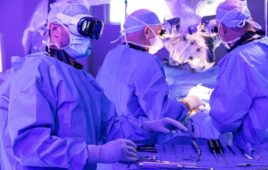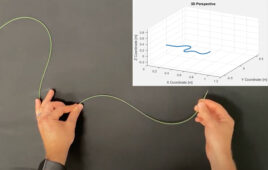 |
This was a female patient, about 40 years old, who had a prior gastric bypass done by another institution. About eight years later, she came to us with chest pain, nausea, vomiting and a bowel obstruction.
When we worked her up, we realized she had a herniation of her gastric pouch and Roux limb into the posterior mediastinum. There were no specific characteristics of the patient that caused this complication. The patient had good weight loss, although she was still obese when we operated on her. She was about 270 lbs., but she did initially lose a good amount of weight – over 100 lbs.
This is an especially interesting case because after bariatric surgery, there are certain types of hernias that one can have internally, but I’d never seen a diaphragmatic hernia of the Roux limb. Normally, if the stomach slips into the chest, it’s either a hiatal or a Paraesophageal hernia. I had never seen this sort of hernia presenting as a small bowel obstruction after gastric bypass.
When we took her to the operating room, we had to reduce the entire gastric pouch as well as a portion of the Roux limb, which was completely kinked and causing her a near total small bowel obstruction. The challenge was to reduce the pouch and Roux limb without devascularizing the blood supply to the limb. The initial concern was that if we couldn’t reduce this down without devascularizing the Roux limb, it would end up becoming a resection and a whole revision, and the complication rate for that is substantial.
The main thing that we did, and learned during the case, is that you have to take your time. That is my main piece of advice in this case. We did very meticulous resection in order to avoid any devascularization of the limb and we took our time doing it. We also had to fully mobilize the esophagus in the chest in order to obtain sufficient intra-abdominal length. You want to reduce the entire contents back into the peritoneal cavity, but you can’t have tension. So, we wanted to get at least two cm of intra-abdominal esophageal length.
Once we repaired and closed the diaphragm, we placed a biologic mesh. In additional to closing the defect, the mesh allows for tissue integration and acts like a lattice for tissue growth, which helps prevent recurrence. The case was a success and today, the patient in this case is doing fantastic.




